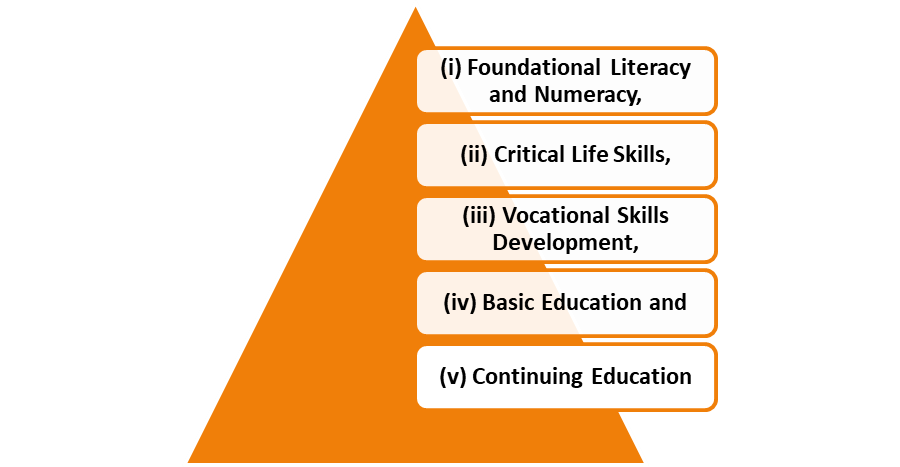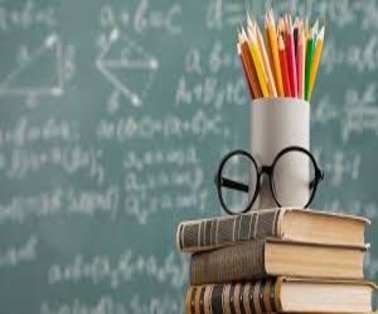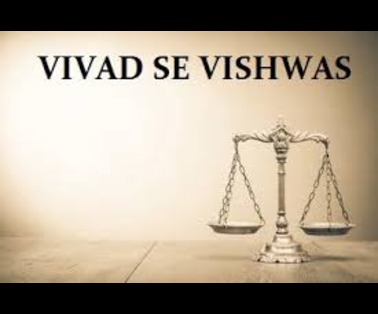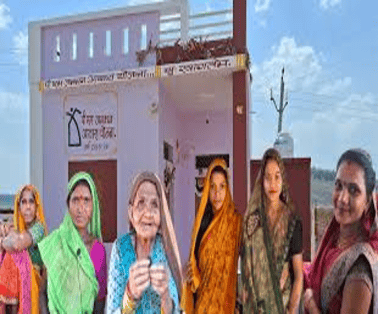Government has launched a new Centrally Sponsored Scheme namely, “New India Literacy Programme” (NILP)
Key Points On New India Literacy Programme
- The scheme will be implemented for five years from the FYs 2022-23 to 2026-27
- The financial outlay of NILP for the five-year implementation period is Rs.1037.90 crore, with Rs.700.00 crore as the Central share and Rs.337.90 crore as the State share.
- The scheme seeks to educate around 5 crore non-literates in the age group of 15 years and above.
Components Of New India Literacy Programme
The New India Literacy Programme has five components:

Details Of New India Literacy Programme
- Foundational Literacy and Numeracy,
- Critical Life Skills (which include, financial literacy, digital literacy, legal literacy, healthcare and awareness, childcare and education, family welfare, etc.),
- Basic Education (includes preparatory (classes 3 – 5), middle (classes 6- 8), and secondary stage (classes 9-12) equivalency),
- Vocational Skills (Skill development will be a part of the continuous learning process for neo-literates to obtain local employment),
- Continuing Education (This includes engaging holistic adult education courses in arts, sciences, technology, culture, sports, recreation, as well as other topics of interest or use to local learners).
Features Of New India Literacy Programme
- Door-to-door surveys are conducted on a mobile app in the States/UTs to identify the beneficiaries of this scheme.
- The primary mode of implementation for the NILP scheme is the online mode, making it accessible to beneficiaries across the country.
- The National Council of Educational Research and Training has developed a curriculum for adult learners that they can master within 200 hours of teaching.
- The curriculum consists of four books, which cover topics such as reading, writing, arithmetic, and critical life skills.
- The teaching and learning resources are provided through the DIKSHA platform of NCERT.
- The New India Literacy Programme scheme is a volunteer-driven scheme that aims to mobilize volunteers across the country to teach non-literates.
- The scheme aims to train 10 lakh teachers to teach one crore adults.
- Further, other modes like TV, Radio, Samajik Chetna Kendra etc. are also to be used for dissemination of Foundational Literacy and Numeracy
Literacy
- The Population Commission of United Nations considers the ability, to both read and write a simple message with understanding in any language, a sufficient basis for classifying a person as Literate
- According to Census of India, ”person aged seven and above, who can both read and write with understanding in any language, is treated as literate”
- It was decided at the 1991 Census that all Children in the age group 0-6, would be treated as illiterate by definition and the population aged seven years and above only would be classified as literate or illiterate
- It is not necessary that to be treated as literate, a person should have received any formal education or acquired any minimum educational standard
- The literacy rate for India in Census 2011, works out to 74.04%
- The corresponding figures for male and female are 82.14% and 65.46% respectively
- Literacy rate in urban areas was higher 87.7% than rural areas with 73.5%, according to 2011 Census
Measures Taken In India Towards Increasing Literacy Rate
- The Constitution of India recognizes the importance of education for all.
- Education of Minorities: Article 30 of the Indian Constitution gives all minorities the right to establish and administer institutions of their own choice
- Free and Compulsory Education: The Constitution of India (u/a 41, 45 and 46 of the Directive Principles of State Policy) instructs the state to ensure that all citizens receive free education
- Sarva Shiksha Abhiyan (SSA): The program was launched in 2001, and it aims to universalise education and improves its quality by time-bound implementation strategy and context-specific planning. It includes children from all social classes
- Midday Meal Scheme: This plan was launched in 1995 to provide mid-day meals to children studying in primary class. The main objective of creating this scheme was to eliminate classroom hunger of children and to increase attendance and enrolment of children at schools
- Beti Bachao, Beti Padhao is the latest initiative taken by Government of India to save and educate the girl child in India.
- The Right to Education (RTE) Act was enacted in 2009, and this Act made education for every child between 6 and 14 years a fundamental right
- The National Education Policy 2020, aims to achieve 100% youth and adult literacy.
What Are The Main Causes of Illiteracy?
- Poor financial conditions can often lead to Illiteracy and vice versa. Families with low income are unable to pay school fees and instead prefer that their children start working at a young age.
- Children brought up by parents who cannot read and write are more likely to stay uneducated
- India still needs more schools in rural and remote areas. Parents hesitate to send their children to a school which is kilometres away from their home
- The lack of awareness regarding the importance of education can increase the illiteracy rate. In remote rural areas, where a larger number of people never had any formal education, illiteracy rates are going to be high
To Download Monthly Current Affairs PDF Click here
Click here to get a free demo
Everything About CLAT 2025
Frequently Asked Questions
The scheme seeks to educate around 5 crore non-literates in the age group of?
The scheme seeks to educate around 5 crore non-literates in the age group of 15 years and above
According to Census of India, person aged Seven and above, who can both read and write with understanding in any language, is treated as literate
Sarva Shiksha Abhiyan (SSA) was launched in which year?
Sarva Shiksha Abhiyan (SSA) was launched in 2001



